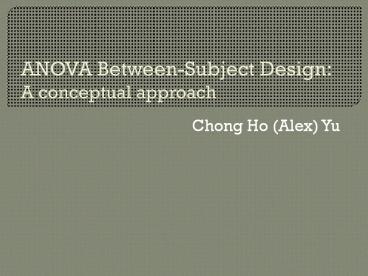ANOVA Between-Subject Design: A conceptual approach - PowerPoint PPT Presentation
Title:
ANOVA Between-Subject Design: A conceptual approach
Description:
Two-way ANOVA Grouping factor and level Between-subject and within-subject Parametric assumptions Variance and F-ratio Confidence intervals and diamond plots ... – PowerPoint PPT presentation
Number of Views:176
Avg rating:3.0/5.0
Title: ANOVA Between-Subject Design: A conceptual approach
1
ANOVA Between-Subject Design A conceptual
approach
- Chong Ho (Alex) Yu
2
Objective
- Illustrate the purpose, the concept, and the
application of ANOVA between-subject design - will NOT walk through the procedure of
hand-calculation you will use a statistical
software package to do your exercises. - By the end of the lesson you will understand the
meaning of the following concepts - One-way ANOVA vs. Two-way ANOVA
- Grouping factor and level
- Between-subject and within-subject
- Parametric assumptions
- Variance and F-ratio
- Confidence intervals and diamond plots
3
What is ANOVA?
- Analysis of variance a statistical procedure to
compare the mean difference - Null hypothesis all means are not significantly
different from each other - Alternate Some means are not equal
4
One-way ANOVA
- There must be three or more groups. If there are
two groups only, you can use a 2-independent-sampl
e t-test. - The independent variable is called the grouping
factor. The group is called the level. In this
example, there is one factor and three levels
(Group 1-3). - .
5
Two-way ANOVA
- There are two grouping factors.
- Unlike one-way ANOVA, in this design it is
allowed to have fewer than three levels (groups)
in each factor. - In this example, there are two factors A and B.
In each factor, there are two levels 1 and 2.
Thus, it is called a 2X2 ANOVA between-subject
design. - In this lesson we focus on one-way ANOVA only,
but you need to know why on some occasions there
are only two groups in ANOVA.
6
What is between-subject?
- Between-subject The subjects in each level
(group) are not the same people (independent).
7
What is within-subject?
- Within-subject The subjects in each level are
the same people (correlated). They are measured
at different points of time. - In this lesson we will focus on the
between-subject ANOVA only
8
Why isnt it called Analysis of means?
- If we want to compare the means, why is it called
Analysis of Variance, not Analysis of Mean?
9
Why isnt it called Analysis of means?
- In the unreal world, the people in the same group
have the same response to the treatment - All people in Group 1 got 10.
- All people in Group 2 got 11.
- All people in Group 3 got 12.
- But in the real world, usually there is
variability in each group (dispersion). We must
take the variance into account while comparing
the means.
10
Parametric assumptions
- Independence The responses to the treatment by
the subjects in different groups are independent
from each other. - Normality The sample data have a normal
distribution. - the variances of data in different groups are not
significantly different from each other.
11
A hypothetical example
- Three different teaching formats (levels) are
used in three different classes
12
When we look at the means alone
13
F ratio
- F signal /noise(error)
- Between-group variance is the signal we want to
see whether there is a significant difference
(variability) between the groups. - Within-group variance is the noise or the error
it hinders us from seeing the between-group
difference when the within-group variances
overlap. - F mean square between / mean square within
- MSB Sum of square between / DF between
- MSW Sum of square within/ DF within
- Effect size eta square SS effect (between) /
SS total
14
ANOVA results
- Mean square between and mean square error ? F
ratio ? Probability (p value) - The p value is smaller than .05 and therefore we
reject the null hypothesis. - Somewhere there is a difference.
- But, where is the difference? Which group can
significantly outperform which? - Many textbooks go into multiple comparison
procedures or post hoc contrast at this point,
but lets try something else.
15
Diamond plots
- Grand sample mean represented by a horizontal
dot line - Group means the horizontal line inside each
diamond is the group means - Confidence intervals The diamond is the CI for
each group
16
Assignment 15
- Download the dataset one_way.jmp from the Ch15
folder. - Run a one-way ANOVA with this hypothesis There
is no significant difference between difference
academic levels in test performance. - Use level as the IV and score as the DV
- Use Test of unequal variances to check whether
the group variances are equal. - If OK, create a diamond plot.
- Is there any performance gap?































